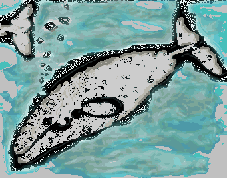
Fig: Jim Nollman

Fig: Jim Nollman |
Echoes and Communications |
Let us simplify: Life is communication and echo is "a probe" to "view" environment.
All living organisms from single bacteria/virus to animals
change information with their environment. Usually communication
is richer inside a speciae than across species. What is echos's
role in this game?
Almost everyone has experiences while playing echo sounds. It was
one of those fascinating games in childhood. There are
archeological observation that can be explained by unifying
rock art and echoes reflected back from the surface
of petroglyphs. This is new idea to understand rock art better.
Steven J. Waller has made this kind of observations and explains that spirits were messaging inside solid rock art sites, which are figured by rock art (rock paintings or petroglyphs). This observation can be utilised by trying to find "good sonoric echo sites" to find petroglyphs. This method has been used independantly in Finland to map Finnish rock paintings.
We all know that, the smoother hard rock surface, the clearer
respond. This is not so interesting, but when echo is transformed
somehow based on the surface structure - imaginations start to
"tell stories". The hard rock start to speak
The nature was full of spirits as aboriginals' folklores tell.
Ancient people could discuss with any part of nature - with
trees, paths, birds, insects, whales and even with rocks. The
Finnish folklore, edited in
Kalevala
has
excellant examples of such communications.
It was interesting to find that ancient Maya cultures perhaps utilised echoes as an phenomen in a controlled way. The observation made by David Lubman covering Maya Pyramids is an interesting example. Mayas builded-up their own "mountains" (pyramids), they created rocky surfaces on them, in order to produce echoes as they like - so they controlled their spiritual world. In a way they knew what was behind that "rock curtain".
A postulate: Human communication is echoes - bouncing back and forth between opponents's complicated structure called "brains". - They say this is communication!
Sometimes human communication is flattened into simple one-to-one echo-like form of communication. William Shakespeare gives a beautiful example in his Hamlet. A conversation between Prince Hamlet and Lord Polonius has abbreviated into a citation "Very like a whale" , which describes fully the nature of "yes-man".
In Steven Spielberg's famous movie "Close Encounter of the 3rd kind" the first contact were realised by simple echoes. In few seconds these echoes were grown into complicated structures impossible to follow or comprehend. This was an amazing invention by Spielberg or whoever made this innovation.
We can encounter similar kind of "event-chains", when trying to follow Jim Nollman 's effort to communicate with his musical instruments with orcas. Usually the contact is made by imitations == echoes of both partners. This will grow fast into more complex structures impossible to follow.
Adam of Bremen wrote in 1074/75 AD a cronicle about "non-Norwegian and non-Christian" people, who lived beyond known Norway. Apparently those people were Samis, who lived in The Northern Scandinavia, Lapponia herding their reindeers.They casually visited Norwegian Sea and Ice Sea for fishing. Adam mentioned also that in winter time those people lived in inland tundras with their reindeers. This proves that they were Lapponian or Sami people.
Adam described an event where those people came on a seashore and communicated with "low level"-throat sounds with cetacea. Here is a clipping of his Latin text and translated into English.
Related topics:
Publications by R. Lauhakangas
A Lithophonic Drum in The Lake Onega, Russia (to be published)